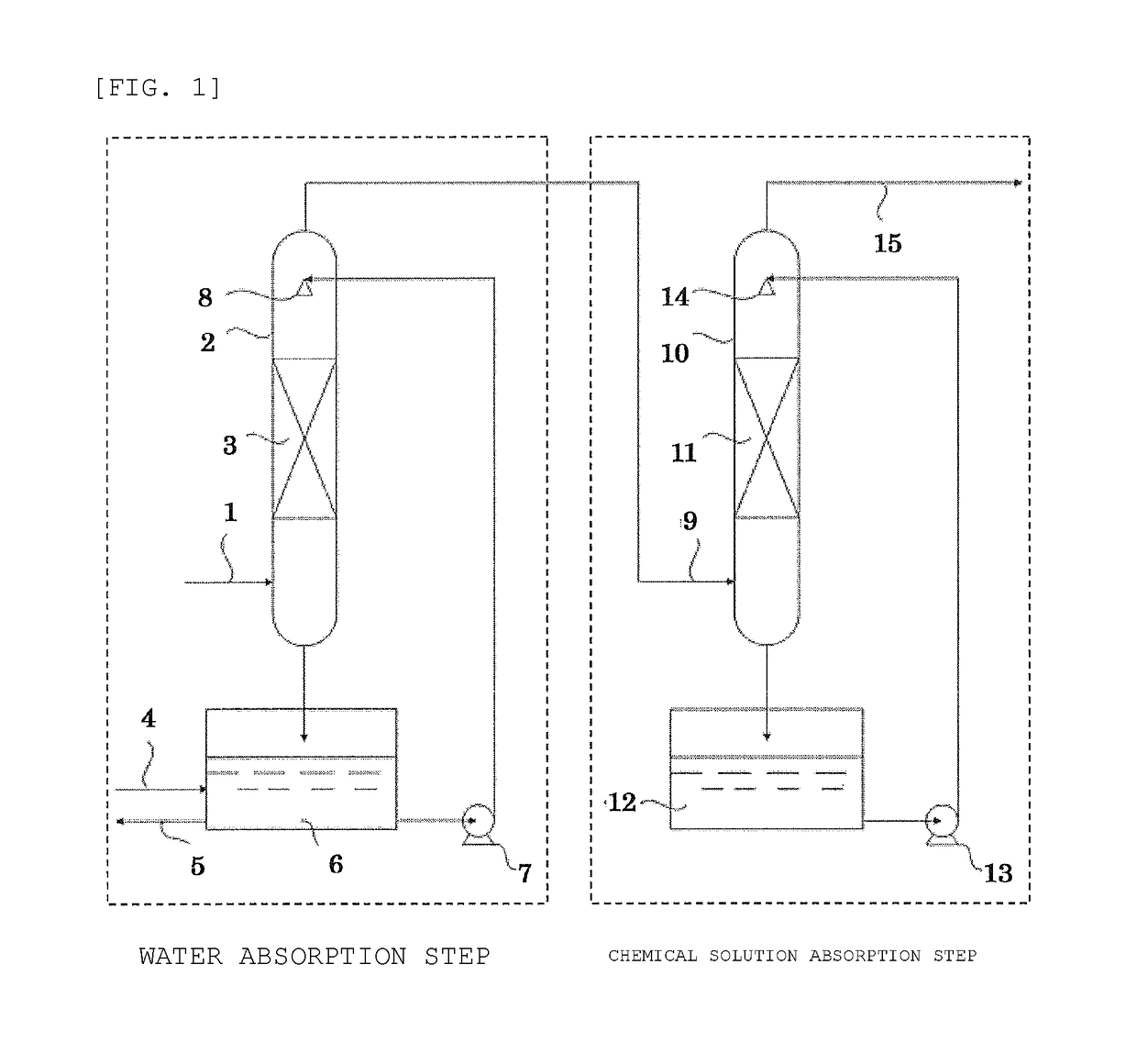Method for treating exhaust gas containing elemental fluorine
- Summary
- Abstract
- Description
- Claims
- Application Information
AI Technical Summary
Benefits of technology
Problems solved by technology
Method used
Image
Examples
example 1
[0065]An exhaust gas including 50% by volume of fluorine gas (F2) (the rest: nitrogen gas) was diluted with air to prepare a diluted gas including 20% by volume of fluorine.
[0066]In a gas washing bottle (capacity: 500 ml) made of Teflon (registered trademark) was placed 250 ml of pure water. While stirring with a stirrer, the diluted gas including 20% by volume of fluorine was introduced from a gas introducing pipe at a flow rate of 90 ml / min, and bubbled to perform a water absorption step. The produced gas was collected at an outlet of the gas washing bottle, and used as a treated gas (c-1) to measure the concentrations of fluorine gas (F2) and oxygen difluoride (OF2). Table 1 shows measurement results. In the treated gas (c-1), fluorine gas was not detected, and 80 ppm by volume of oxygen difluoride was detected.
example 2
[0067]The exhaust gas dilution and the water absorption step were performed in the same manner as Example 1 to obtain the treated gas (c-1).
[0068]Next, in a gas washing bottle (capacity: 500 ml) made of Teflon (registered trademark) containing 250 ml of 3% by mass sodium thiosulfate as an absorbing liquid, the treated gas (c-1) was introduced from a gas introducing pipe at a flow rate of 90 ml / min, and bubbled while stirring with a stirrer to perform a chemical solution absorption step. The produced gas was collected at the outlet of the gas washing bottle, and used as a treated gas (d-1) to measure the concentrations of fluorine gas (F2) and oxygen difluoride (OF2). Table 1 shows measurement results. In the treated gas (d-1), neither fluorine gas nor oxygen difluoride was detected.
example 3
[0069]An exhaust gas including 50% by volume of fluorine gas (F2) (the rest: nitrogen gas) was diluted with air to prepare a diluted gas including 5% by volume of fluorine gas.
[0070]The water absorption step was performed in the same manner as Example 1 except for using the diluted gas including 5% by volume of fluorine gas, and the produced gas was collected at the outlet of the gas washing bottle to obtain a treated gas (c-2). Table 1 shows results of measurements of the concentrations of fluorine gas (F2) and oxygen difluoride (OF2) in the treated gas (c-2). In the treated gas (c-2), fluorine gas was not detected, and 6 ppm by volume of oxygen difluoride was detected.
PUM
| Property | Measurement | Unit |
|---|---|---|
| Fraction | aaaaa | aaaaa |
| Fraction | aaaaa | aaaaa |
| Percent by volume | aaaaa | aaaaa |
Abstract
Description
Claims
Application Information
 Login to View More
Login to View More - R&D
- Intellectual Property
- Life Sciences
- Materials
- Tech Scout
- Unparalleled Data Quality
- Higher Quality Content
- 60% Fewer Hallucinations
Browse by: Latest US Patents, China's latest patents, Technical Efficacy Thesaurus, Application Domain, Technology Topic, Popular Technical Reports.
© 2025 PatSnap. All rights reserved.Legal|Privacy policy|Modern Slavery Act Transparency Statement|Sitemap|About US| Contact US: help@patsnap.com

